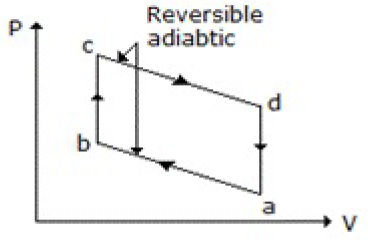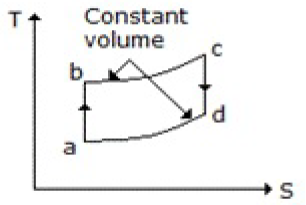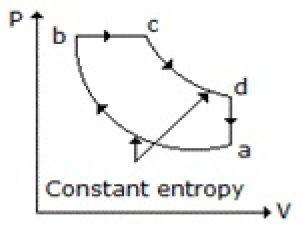Translational kinetic energy of molecules of an ideal gas is proportional to (where, T = absolute temperature of the gas)
T
√T
T2
1/√T
Correct Answer :
A. T
Related Questions
Ideal gas law is applicable at
Low T, low P
High T, high P
Low T, high P
High T, low P
The third law of thermodynamics states that the
Heat capacity of a crystalline solid is zero at absolute zero temperature
Heat transfer from low temperature to high temperature source is not possible without external work
Gases having same reduced properties behaves similarly
None of these
When pressure is applied on the system, ice ↔ water, then
Equilibrium cannot be established
More ice will be formed
More water will be formed
Evaporation of water will take place
The chemical potential of a component (μi) of a phase is the amount by which its capacity for doing all work, barring work of expansion is increased per unit amount of substance added for an infinitesimal addition at constant temperature and pressure. It is given by
(∂E/∂ni)S, v, nj
(∂G/∂ni)T, P, nj = (∂A/∂ni) T, v, nj
(∂H/∂ni)S, P, nj
All (A), (B) and (C)
For a constant volume process __________ by the system is used only to increase the internal energy.
Heat absorbed
Work done
Both (A) & (B)
Neither (A) nor (B)
__________ does not change during phase transformation processes like sublimation, melting & vaporisation.
Entropy
Gibbs free energy
Internal energy
All (A), (B) & (C)
When a gas is subjected to adiabatic expansion, it gets cooled due to
Decrease in velocity
Decrease in temperature
Decrease in kinetic energy
Energy spent in doing work
Entropy of a substance remains constant during a/an __________ change.
Reversible isothermal
Irreversible isothermal
Reversible adiabatic
None of these
Which of the following processes cannot be made reversible even under ideal condition of operation?
Free expansion of a gas
Compression of air in a compressor
Expansion of steam in a turbine
All (A), (B) & (C)
Which of the following represents the Virial equation of state?
T = [RT/(V- b)] - [a/√T. V(V + b)]
PV/RT = 1 + (B/V) + (C/V2) + ……
n1u2 + μ2μ1 = 0
None of these
An isentropic process is carried out at constant
Volume
Pressure
Temperature
All (A), (B) and (C)
Throttling process is a/an __________ process.
Reversible and isothermal
Irreversible and constant enthalpy
Reversible and constant entropy
Reversible and constant enthalpy
Internal energy is equal to the heat absorbed in case of a/an __________ process.
Constant volume
Polytropic
Adiabatic
Constant pressure
The standard Gibbs free energy change of a reaction depends on the equilibrium
Pressure
Temperature
Composition
All (A), (B) and (C)
The fugacity of a gas in a mixture is equal to the product of its mole fraction and its fugacity in the pure state at the total pressure of the mixture. This is
The statement as per Gibbs-Helmholtz
Called Lewis-Randall rule
Henry's law
None of these
Which one is true for a throttling process?
A gas may have more than one inversion temperatures
The inversion temperature is different for different gases
The inversion temperature is same for all gases
The inversion temperature is the temperature at which Joule-Thomson co-efficient is infinity
A solid is transformed into vapour without going to the liquid phase at
Triple point
Boiling point
Below triple point
Always
Heating of water under atmospheric pressure is an __________ process.
Isochoric
Isobaric
Adiabatic
Isothermal
For a real gas, the chemical potential is given by
RT d ln P
RT d ln f
R d ln f
None of these
The enthalpy change when ammonia gas is dissolved in water is called the heat of
Solution
Formation
Dilution
Combustion
Which of the following diagrams does not represent an Otto cycle?



None of these
Refrigerants commonly used for domestic refrigerators are
Ethyl chloride or methyl chloride
Freon-12
Propane
NH3 or CO2
For an isothermal reversible compression of an ideal gas
Only ΔE = 0
Only ΔH =0
ΔE = ΔH = 0
dQ = dE
Efficiency of a heat engine working on Carnot cycle between two temperature levels depends upon the
Two temperatures only
Pressure of working fluid
Mass of the working fluid
Mass and pressure both of the working fluid
For an ideal solution, the value of activity co-efficient is
0
1
< 1
> 1
Number of degrees of freedom for a three phase system in equilibrium comprising of three nonreacting chemical species is
2
0
1
3
For water at 300°C, it has a vapour pressure 8592.7 kPa and fugacity 6738.9 kPa Under these conditions, one mole of water in liquid phase has a volume of 25.28 cm3 and that in vapour phase in 391.1 cm3.Fugacity of water (in kPa) at 9000 kPa will be
6738.9
6753.5
7058.3
9000
For a constant volume process
dE = CpdT
dE = CvdT
dQ = dE + pdV
dW = pdV
The equation Tds = dE - PdV applies to
Single phase fluid of varying composition
Single phase fluid of constant composition
Open as well as closed systems
Both (B) and (C)
The relation connecting the fugacities of various components in a solution with one another and to composition at constant temperature and pressure is called the __________ equation.
Gibbs-Duhem
Van Laar
Gibbs-Helmholtz
Margules
